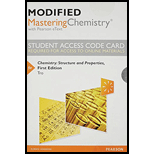
Concept explainers
Which compound is most soluble in octane (C8H18)?
- CBr4
- H2O
- NH3
- CH3OH
Interpretation: To find which compound is most soluble in octane
Concept introduction:
A chemical property which refers to the capability for a given substance such as solute to dissolve in the solvent is known as solubility. At equilibrium it is also measured in terms of the maximum amount of solute that is dissolved in specified amount of solvent.
Correct answer: Option (a)
Explanation of Solution
Reason for the correct answer: The given compound octane is found to be a non-polar solvent. Generally, the non-polar solute or solvent will immediately get soluble in octane as the thumb rule of solubility is like dissolves like. Among the given compounds
Want to see more full solutions like this?
Chapter 14 Solutions
Modified Mastering Chemistry with Pearson eText -- Standalone Access Card -- for Chemistry: Structure and Properties
- Starch contains CC, CH, CO, and OH bonds. Hydrocarbons have only CC and CH bonds. Both starch and hydrocarbons can form colloidal dispersions in water. Which dispersion is classified as hydrophobic? Which is hydrophilic? Explain briefly.arrow_forwardHow much N2 can dissolve in water at 25 C if the N2 partial pressure is 585 mm Hg?arrow_forwardPredict the relative solubility of each compound in the two solvents, on the basis of intermolecular attractions. (a) Is NaCl more soluble in water or in carbon tetrachloride? (b) Is I2 more soluble in water or in toluene (C6H5CH3)? (c) Is ethanol (C2H5OH) more soluble in hexane or in water? (d) Is ethylene glycol (HOCH2CH2OH) more soluble in ethanol or in benzene (C6H6)?arrow_forward
- Predict the relative solubility of each compound in the two solvents, on the basis of intermolecular attractions. (a) Is Br2 more soluble in water or in carbon tetrachloride? (b) Is CaCl2 more soluble in water or in benzene (C6H6)? (c) Is chloroform (CHCl3) more soluble in water or in diethyl ether [(C2H5)2O]? (d) Is ethylene glycol (HOCH2CH2OH) more soluble in water or in benzene (C6H6)?arrow_forwardSodium chloride (NaCl) is commonly used to melt ice on roads during the winter. Calcium chloride (CaCl2) is sometimes used for this purpose too. Let us compare the effectiveness of equal masses of these two compounds in lowering the freezing point of water, by calculating the freezing point depression of solutions containing 200. g of each salt in 1.00 kg of water. (An advantage of CaCl2 is that it acts more quickly because it is hygroscopic, that is. it absorbs moisture from the air to give a solution and begin the process. A disadvantage is that this compound is more costly.)arrow_forwardA 13.0% solution of K2CO3 by mass has a density of 1.09 g/cm3. Calculate the molality of the solution.arrow_forward
- Indicate which of the following is more soluble in ethanol, C2H5OH: acetic acid, CH3COOH, or stearic acid, C17H35COOH.arrow_forwardPredict the relative solubility of each compound in the two solvents, based on the intermolecular attractions. (a) Is potassium iodide more soluble in water or in methylene chloride (CH2Cl2)? (b) Is toluene (C6H5CH3) more soluble in benzene (C6H6) or in water? (c) Is ethylene glycol (C2H4(OH)2) more soluble in hexane (C6H14) or in ethanol (C2H5OH)?arrow_forward6-60 Predict which of these covalent compounds is soluble in water. (a) C2H6 (b) CH3OH (c) HF (d) NH3 (e) CCI4arrow_forward
 Introduction to General, Organic and BiochemistryChemistryISBN:9781285869759Author:Frederick A. Bettelheim, William H. Brown, Mary K. Campbell, Shawn O. Farrell, Omar TorresPublisher:Cengage Learning
Introduction to General, Organic and BiochemistryChemistryISBN:9781285869759Author:Frederick A. Bettelheim, William H. Brown, Mary K. Campbell, Shawn O. Farrell, Omar TorresPublisher:Cengage Learning
 ChemistryChemistryISBN:9781305957404Author:Steven S. Zumdahl, Susan A. Zumdahl, Donald J. DeCostePublisher:Cengage Learning
ChemistryChemistryISBN:9781305957404Author:Steven S. Zumdahl, Susan A. Zumdahl, Donald J. DeCostePublisher:Cengage Learning Chemistry: An Atoms First ApproachChemistryISBN:9781305079243Author:Steven S. Zumdahl, Susan A. ZumdahlPublisher:Cengage Learning
Chemistry: An Atoms First ApproachChemistryISBN:9781305079243Author:Steven S. Zumdahl, Susan A. ZumdahlPublisher:Cengage Learning Chemistry: Principles and PracticeChemistryISBN:9780534420123Author:Daniel L. Reger, Scott R. Goode, David W. Ball, Edward MercerPublisher:Cengage Learning
Chemistry: Principles and PracticeChemistryISBN:9780534420123Author:Daniel L. Reger, Scott R. Goode, David W. Ball, Edward MercerPublisher:Cengage Learning General, Organic, and Biological ChemistryChemistryISBN:9781285853918Author:H. Stephen StokerPublisher:Cengage Learning
General, Organic, and Biological ChemistryChemistryISBN:9781285853918Author:H. Stephen StokerPublisher:Cengage Learning





